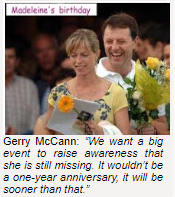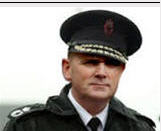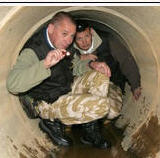PeterMac's new chapter for his e-Book: Chapter 35: Mirage
The Complete Mystery of Madeleine McCann™ :: Madeleine Beth McCann :: PeterMac's FREE e-book: What really happened to Madeleine McCann?
Page 1 of 1 • Share
 PeterMac's new chapter for his e-Book: Chapter 35: Mirage
PeterMac's new chapter for his e-Book: Chapter 35: Mirage
A Diversion on Observation, and the influence of our previous Knowledge and Beliefs
This chapter is something of a diversion.
In it I shall examine how we can think or believe we see something, when in fact the objective and scientifically provable truth of the matter is that we either did not, or that we saw something else.
We were not ‘lying’ or being dishonest when we told what we saw. We saw something and our mind forced us to interpret it in a particular way.
We can only fit what we see into categories we already know and understand. Before the discovery of Oxygen the phenomenon of burning could not be interpreted as oxidation, and so Phlogiston was a rational but ultimately flawed attempt at explanation.
Medical treatment is the most obvious case of rapidly changing knowledge, exposing millennia of previous professionally agreed diagnosis and treatment as nothing better than ignorant superstition. Even ‘modern medicine’ is being exposed in a similar way. The last frontal lobotomy was performed as late as 1967, and the leading Medical journal in the UK is The Lancet, betraying its origins in the bloodletting prevalent as a treatment and recommended in medical texts up to 1923, but now condemned as ignorant and misguided barbarism. Every new treatment implicitly criticises the previous one. We no longer prescribe Insulin Shock Therapy for schizophrenia, cocaine for toothache, cigarettes to “ease the chest”, or Bed Rest for “hysterical women”.
Through history this has always been the case. Historical observations can be reviewed and interpreted in the light of modern scientific knowledge, and we must be humble enough to recognise that our current observations and explanations will in turn inevitably be interpreted differently in the future. Archaeologists are recognizing this and in some places are deliberately leaving significant parts of sites untouched for future generations to explore.
Continental Drift started as an interesting theory, ridiculed by Sir David Attenborough’s own Cambridge professor, which evolved into Plate Tectonics and remained at the level of highly probable theory until someone sent a submarine down to the mid-Atlantic ridge and actually filmed it happening. And Sir David had the last laugh – but only for the time being.
As Agent K said in “Men in Black”, “Fifteen hundred years ago, everybody knew that the Earth was the centre of the universe. Five hundred years ago, everybody knew that the Earth was flat. And fifteen minutes ago, you knew that humans were alone on this planet. Imagine what you'll know tomorrow.”
[Wrong about the flat earth, incidentally. They knew it was a sphere, just not how big it was.]
So what follows is a quick trip through a Case History.
Once or twice a year I am able to see North Africa from my house on the coast of southern Spain.
Like this > > >
It is the range of mountains called the Riff in northern Morocco.
The peaks in the Riff rise to 2500 m. and are big and pointy as are the mountains behind me. Both coasts lack a coastal plain, with the mountains apparently rising straight out of the deep sea.
[Both are formed by the same geological event, as the African plate pushes north into the European plate and forces up mountains which run E-W; the whole of Spain then gets lifted up so the central meseta (plateau or tableland) is around 700 m. or 2,500 ft.
The whole thing goes on pushing north until it hits France and the resulting folds form the Pyrenees. It is moving at about 1 cm. a year. That same pressure causes the north coast of Africa to wrinkle up. It explains why there is limestone with shells from the Jurassic era 2,500 feet up in the air !
End of geography lesson.]
BUT – – I am 140 m. above sea level, so the visible horizon can be calculated at 42 km.
AND – – that bit of Morocco is about 190 km. away
horizon (in km.) = 3.569 x √ height of observer (in metres)
The Mathematics behind this Calculation
This calculation should be taken as a guide only as it assumes the earth is a perfect ball 6,378,137 metres radius. It also assumes the horizon you are looking at is at sea level. A triangle is formed with the centre of the earth (C) as one point, the horizon point (H) is a right angle and the observer (O) the third corner. Using Pythagoras's theorem we can calculate the distance from the observer to the horizon (OH) knowing CH is the earth's radius (r) and CO is the earth's radius (r) plus observer's height (v) above sea level.OK so far ?
I am clearly seeing much more than just the tip of the mountains.
Some more calculations
Horizon distance (km.) = 3.569 x √ height (m.)
The terrace of my house is approx. 140 m. √ 140 = 11.832
So 3.569 x 11.832 = 42 km.
Clearly I cannot directly see the coast of Morocco, which is 160 km. at its nearest point (Ceuta) and 190 km in the direction I am looking.
But I am clearly seeing a mountain range, not a cloud bank.
The high peak above Chefchaouen (Jeb al Kalaa) is 2200 m. and √ 2200 = 46.904
So the horizon visible from that peak will be given as 3.569 x 46.904 = 167 km.
Adding the two distances we get
42 + 167 = 209 km.
Distance from my house to Jeb al Kalaa = 214 km.
So it is NOT possible to see even the peak of the mountain directly.
Let us go higher
The top of Pico Veleta, the ski slope above Granada, Sol y Nieve, is 3340 m. √ 3340 = 57.793
From there the visible horizon is
3.569 x 57.793 = 206 km.
Adding the two horizon distances we get. 206 + 167 = 373 km.
Pico Veleta to Jeb al Kalaa is 269 km
Which sounds promising. There should be a direct line of sight
but let us do the reverse calculation
206 minus 167 = 39 km. This is what we may term the “overlap” distance between the horizons
Putting the 39 km back into the equation and reversing the procedure
If 3.569 x √height = 39 km, then √height = 39 / 3.569 = 10.927 and 10.927² = 119 m.
Therefore height = 119 m.
So you could only directly see the top 119 metres of the mountain, – at a distance of 270 km – against a sea horizon.
Could this be done without a powerful telescope and almost perfect air conditions, in daylight ?
119 m. at a distance of 270,000 m, will subtend an angle of only 90 seconds of arc.
(Pythagoras says so)
The resolution limit of human vision is around 0.006 degrees. That is 22 seconds of arc
(The sun and the moon subtend 31 arc minutes. Half a degree).
(Forget stars. They act in a different way, as their light is scattered by the atmosphere giving a larger apparent size than Pythagorus would allow !)
So even from the top of Pico Veleta it would be only the size of a grain of salt on your finger at the end of your outstretched arm. Salt grain 0.3 mm. Arm 0.75m. Angle = 0.0229º = 83 seconds
And it would be only just poking out over the horizon with nothing much either side to draw your attention to it.
* * * *
For those who have not keeled over with boredom already, I believe we have established that it is impossible to see the mountain above Chefchaoen by direct line of sight. Even with a telescope.
Even from a high mountain.
And yet I did.
And I have the photos to prove it.
Or more accurately – I believe I did.
As do many other people who have reported this on-line and in local papers.
Let us allow ourselves to think that this might be a strange nautical related phenomenon, as they now think happened with Titanic.
In brief this involves clear and flat calm conditions, with layers of extremely cold air, and so the stars reflected off a bank much lower down, the ice was not visible, and the lookout had no chance.
The documentary at https://www.youtube.com/watch?v=UxQvij8Ttug is revealing and instructive. The explanation from 1:00, then clips at 1:11 and 1:17 are enough to make the point.
These are stills from that presentation.
A passing ship
becoming this, with an inverted image above the real one
And an island with a clear horizon beyond
becoming this
My photos were taken on Christmas Day, 25/12/19 around 6:30pm Spanish time
Here we had good clear and flat calm weather, so Morocco would have been hot during the day. At dusk as the air begins to cool it flows down the mountain slopes, generating a Catabatic or Föhn wind, so forming a gentle but steady stream of warm air which then floats on the layer of cold air over the sea.
It seems to fit
It would also explain why I notice this only once every couple of years. Everything will have to be perfect. A bit of westerly through the Gibraltar Strait will disrupt the layering effect.
And also why I have only seen it at sunset, when the mountain begins to cool.
We get catabatic breezes in the summer here on the complex from the hill behind us, which can make the sun shades flap for a few minutes, but everything has to be perfect to notice the effect.
Just for comparison I shall attach photos of what the skyline normally looks like on a clear evening, with ships in the offing, and one of a line of cloud showing where the mountains in the Riff are, but well below any possible sightline.
And then we look for more evidence
The sea temperature was around 16ºC
The temperature in Chefchaouen had been climbing to near 26º for much of the day,
by 1800 the wind fell to 3mph = Beaufort force 1 = "light air". smoke drifts, small ripples on the sea and it was due SOUTH. In other words a catabatic wind.
So we have warmer air drifting downhill and out across a flat calm cold sea, none of it disturbed by wind or waves, and at 1830 I am able to take photos of the mirage, and it stays until dark.
The three things have to occur simultaneously.
Which is perhaps why it is so rare
So I perform some more observations and calculations.
The bearing of small chimneys to the right of the pyramidal roof is a good starting point. Using a crude but effective “compass” App on my phone, and two screws as sights (!) I get a bearing of 213º.
Using “google maps” to obtain the coordinates of the two points and putting them into the computer programme it gives me 215º. Which I hope you will agree is within the limits of the thickness of two screws resting on a phone on a pillar on a roof seen with the naked eye.
It also confirms google maps’ distance of 214 km.
THEREFORE:
It is a mirage
I did NOT see or photograph the mountains
I saw and photographed an image of the mountains caused by a particular set of meteorological circumstances.
It was real only in the sense that a reflection in a mirror is real.
QED
OK. I know it is not actually called a mirage.
Strictly a Mirage is an inverted image, a reflection of what is on the ground, often water, projected onto an air layer higher up, so we can see it. As in the photo of the ship supra
The technical name for what I observed and photographed is “Looming”, as in the standard English usage of an image ‘looming’ up, or ‘looming’ out of the mist. If you google that term you will see a lot of technical and Nautical stuff about it.
“Looming” keeps the image the right way up. It is not a reflection, it is a significant refraction.
Something like this
QUOTE: LOOMING: The appearance above the horizon of a distant object that would normally be hidden below it. This effect is caused by unusually large terrestrial refraction, usually due to a thermal inversion. Looming is the opposite of sinking. Both are refraction phenomena, but not mirages.
What do I normally see ?
This. Spot the blob on the horizon
Which resolves with a telescope into this . . . Not a mountain.
Or this, a bank of cloud on the far horizon showing where the Riff mountains range is, but not bringing it into view.
Another mystery solved ?
What has this to do with the case that interests us ?
We can only understand things by reference to our own belief system and within our own corpus of knowledge.
As we know some belief systems, particularly religious ones, will not permit new knowledge to intrude. Galileo Galilei and several others have had that problem. Western philosophy has now matured a little and seems more open to new scientific findings, although it is far from perfect.
In classic detective stories the lay people are frequently shown concentrating round the victim or at the ‘scene of the crime’. The ace detective is then depicted doing something completely different, unexpected, and often apparently inexplicable – examining a pocket watch, looking for cigarette stubs in the neighbouring field, or asking for cheque stubs or to see a diary or address book.
Why ? Because the detective has specialised knowledge, not of this crime in itself, but of the importance of detaching one’s mind from the obvious focus and opening it up to all possibilities, however apparently absurd.
What has this to do with the case that interests us so much ?
The first people at the MBM scene (those who did not know the full facts) may be excused for initially believing what they were told. They have no corpus of knowledge from which to judge what they are told against what they see.
Police officers have a different ‘corpus’ and immediately grasped that what they were being told did not match what they were seeing.
We are struck by the report that the only people to ‘examine’ the infamous shutters were GM, who said he could open them, and some time later, strangely, DW, who said she couldn’t.
Everyone else seems to have passively accepted what they were being told.
The Police on the other hand did examine them, in microscopic and forensic detail, and determined that all the stories were false, or incapable of verification.
We are also struck by the search conducted during the first few days by many, possibly hundreds, of holidaymakers. It is not clear what they believed, nor whether they were instructed to search for a living girl and to challenge and check any they came across, or to look for a cadaver.
Did they think when they were told of Abduction, that the sequence was to be
Abducted - Abused - Released,
or
Abducted – Murdered - Dumped ?
Did they think at all ? We are not told.
More interestingly the only account of any search by the parents, during the short jogging session early the following morning, indicated only too clearly that they were pretending – allegedly – to look for a corpse.
The private investigators had to be told what to believe. Those who strayed outside the parameters either resigned or were sacked.
The professional detectives who strayed outside what they had been told had to be dealt with by denigration and vilification, or through the courts of law.
After three weeks we were presented with a photo within which was embedded a time and date. Many people’s knowledge and belief would not allow any further investigation. Not because people are stupid or gullible, but because they have no knowledge base which would allow them to think anything else.
An incorrigible cynic, however, with a background of believing nothing unless it be independently verified from unconnected sources, did the unthinkable, and looked at the photo not as proof of MBM’s continued existence, but as a documentary record of weather conditions at the time, day, and date provided.
And in seeking to confirm the weather conditions from independent sources found that they could not be. Which led to the strong suggestion that the photo itself could not have been taken at that time, day and date.
As with the Mirage / Looming
Some of my friends here are telling me of instances where they too ‘saw’ the mountains of Africa from Spain. They firmly believe they ‘saw’ them, and put this down to ‘exceptionally clear air’.
Or at least they did until I sent them the text with the science, the mathematics and the calculations.
Some time ago and over some years Harvard University conducted a series of experiments in “Changing people’s minds”. They are summed up in a New Yorker article in which one of the more telling sentences is “ . . . Humans, they point out, aren’t randomly credulous. Presented with someone else’s argument, we’re quite adept at spotting the weaknesses. Almost invariably, the positions we’re blind about are our own.”
And later
“Providing people with accurate information doesn’t seem to help; they simply discount it. Appealing to their emotions may work better, but doing so is obviously antithetical to the goal of promoting sound science. “The challenge that remains . . . is to figure out how to address the tendencies that lead to false scientific belief.”
So the strategy of implanting a belief in an otherwise empty mind is self-evidently a good one. The results are clear. All argument and evidence against the “Official Version of the Truth” are rejected. Simply discounted - in the words of the article.
Not an encouraging situation
POST SCRIPTUM
I cannot resist the temptation to quote my favourite private detective, and to apply his wisdom to the instant case.
Never trust upon general impressions, my boy, but concentrate yourself upon details.
Extract from “A Scandal in Bohemia”
“Quite so,” he answered, lighting a cigarette, and throwing himself down into an armchair. “You see, but you do not observe. The distinction is clear. For example, you have frequently seen the steps which lead up from the hall to this room.”
“Frequently.”
“How often?”
“Well, some hundreds of times.”
“Then how many are there?”
“How many? I don't know.”
“Quite so! You have not observed. And yet you have seen. That is just my point. Now, I know that there are seventeen steps, because I have both seen and observed.”
Extracts from the forthcoming “A Scandal in Portugal”
“Quite so, You see, but you do not observe. The distinction is clear. For example, you have frequently seen the shutters which open from the car park into this room.”
“Frequently.”
“How often?”
“Well, some hundreds of times.”
“Then how are they operated ?”
“How ? I don't know.”
“Quite so! You have not observed. And yet you have seen. That is just my point. Now, I know that they are raised by a strap on the inside, and cannot be opened sufficiently from the outside, because I have both seen and observed.”
“You have also frequently seen the photo which shows the girl with her father and sister at the pool.”
“Frequently.”
“How often?”
“Well, some hundreds of times.”
“Then what were the actual weather conditions on the day in question ?”
“Weather ? On the day ? I don't know.”
“Quite so! You have not observed. And yet you have seen. That is just my point. Now, I know that the weather that day was cold and windy and overcast, because I have both seen and observed.”
Some Refs:
https://www.quora.com/When-I-look-out-into-the-ocean-how-far-away-is-the-horizon-How-much-of-the-ocean-can-I-actually-see
http://www.ringbell.co.uk/info/hdist.htm
https://dizzib.github.io/earth/curve-calc/?d0=250&h0=5200&unit=metric
https://rechneronline.de/sehwinkel/distance-horizon.php
https://planetcalc.com/7042/
https://www.calculatorsoup.com/calculators/conversions/convert-decimal-degrees-to-degrees-minutes-seconds.php
https://www.newyorker.com/magazine/2017/02/27/why-facts-dont-change-our-minds
 Similar topics
Similar topics» PeterMac's FREE e-book: CHAPTER 63 Addendum A response to critiques of Chapter 63 – SmithGerryMan
» Chapter 28: 'The Pool Photo refuses to go away' + Appendix (Chapter 29) Two Photos that tell an important story
» Latest from PeterMac's FREE e-book: CHAPTER 63 SMITH-GERRY-MAN SCRUTINISED
» Prosecution Exhibit 1: 'madeleine' - What's in the book?
» PeterMac's FREE e-book: Chapter 51 Some random unrelated thoughts
» Chapter 28: 'The Pool Photo refuses to go away' + Appendix (Chapter 29) Two Photos that tell an important story
» Latest from PeterMac's FREE e-book: CHAPTER 63 SMITH-GERRY-MAN SCRUTINISED
» Prosecution Exhibit 1: 'madeleine' - What's in the book?
» PeterMac's FREE e-book: Chapter 51 Some random unrelated thoughts
The Complete Mystery of Madeleine McCann™ :: Madeleine Beth McCann :: PeterMac's FREE e-book: What really happened to Madeleine McCann?
Page 1 of 1
Permissions in this forum:
You cannot reply to topics in this forum



























































